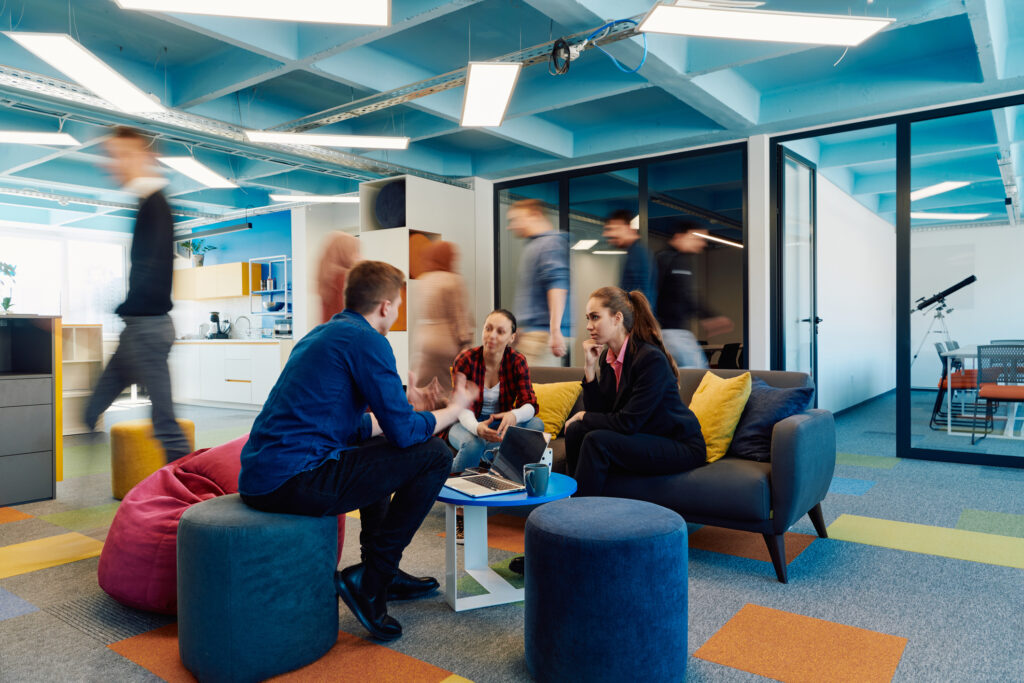What coworking means today and why its history matters
Coworking today refers to flexible, membership-based workspaces shared by professionals from different backgrounds. As of 2023, over 28,000 coworking spaces operate globally. The idea has evolved over decades, shaped by shifting work norms, real estate innovation, and technological advancements.
Understanding to understand today’s global coworking movement, it’s important to look back at coworking history. Apart from nostalgia, it shows how flexible work moved from the margins to the mainstream, where the earliest coworking spaces took shape, and why the model still makes sense in a hybrid world. From serviced offices in the 1970s to today’s global coworking networks, this article explores the key moments that helped reshape how and where people work.
Let’s take a closer look at the history of coworking spaces.
Proto-Coworking: Pre-1990s Precursors
Quick Summary:
-
Coworking principles existed before the term, in creative and tech spaces
-
Early examples included communal studios, salons, and hacker labs
-
The 1960s–70s introduced serviced offices like OmniOffices
-
These formats laid the groundwork for today’s flexible workspace industry
Before the word “coworking” was coined, the concept already existed, just under different names and formats. Artists, freelancers, and technical communities had long used shared spaces to work, collaborate, and exchange ideas.
So really, the first coworking space is historically difficult to track.
In the mid-20th century, communal studios, bohemian salons, and early hacker labs functioned as the cultural and creative forerunners to coworking. These were informal environments where shared tools, ideas, and space were more important than fixed desks or company branding. Across Europe and North America, incubator-like hubs for independent creatives, developers, and early-stage founders quietly built the case for shared work.
At the same time, more commercial forms of flexible space began to emerge. In the 1960s and 1970s, companies like OmniOffices introduced serviced offices—private suites available with mail handling, receptionist services, and monthly terms. These spaces offered convenience and infrastructure whilst removing long-term leases and high-investment fit-outs from the equation.
In Australia, the groundwork for what would eventually become global coworking was also underway. A young company named Servcorp, founded in Sydney in 1978, would soon play a defining role in bridging the gap between serviced offices and what the world now recognizes as coworking.
The Pioneers of The Coworking Revolution: 1978
Quick summary:
-
Servcorp was founded in Sydney in 1978 by Alfred Moufarrige
-
Its first office was divided with chalk lines on the MLC Centre carpet
-
Introduced the virtual office concept in 1980 – this concept built the fundamentals for the first official coworking space
-
Listed on the Australian Stock Exchange in 1999
-
As of 2025, operates 150+ centers in 40+ cities globally
Servcorp didn’t technically invent coworking, but it built the business model that made it scalable. In 1978, Alfred Moufarrige launched Servcorp in Sydney’s MLC Centre with a vision that combined corporate professionalism with shared flexibility. He famously marked out offices on the floor with chalk to divide up the first shared workspace.
By 1980, only two years after launching, Servcorp introduced the virtual office. It was a significant shift, giving businesses access to a premium address, professional call handling, and mail services without committing to a fixed office location.
By 1999, Servcorp was publicly listed on the Australian Securities Exchange (ASX), becoming one of the few workspace providers to reach an enterprise scale. Its model bridged the gap between flexible office spaces and today’s more fluid coworking environments. In 2025, Servcorp continues to operate more than 150 locations across 40+ cities, promoting its trademarked “Everything but the office” lifestyle.
It holds a unique position in coworking space history: not quite a coworking space by today’s standards, but a critical enabler of the shift away from long-term leases and high-cost fit-outs.
Naming The Concept: “Coworking” Coined in 1999
Quick Summary:
-
The term “coworking” was coined by software engineer Bernard DeKoven in 1999
-
Originally described a philosophy of collaborative, equal-footed working
-
It wasn’t tied to a physical space at first
-
The term laid the conceptual groundwork for the coworking movement
The word “coworking” didn’t originate in commercial office space. It began as a philosophy.
In 1999, Bernard DeKoven, a software engineer and game designer, used the term to describe a way of working focused on collaboration, shared knowledge, and mutual respect between peers. His definition was about how people work together, not where they do it. At the time, coworking referred to voluntary collaboration, often without a shared physical location.
This idea was distinct from serviced offices or traditional office setups. It wasn’t built around infrastructure or business amenities.
It centered on work culture. The core elements that built this were decentralized, peer-driven, and aligned with the needs of early freelancers and digital workers in the 2000s.
Although the term started as a conceptual label, it gave shape to a growing shift in how people wanted to work. After a couple of years, coworking became tied to real, physical coworking spaces that reflected DeKoven’s original intent: open, flexible environments for connection and community.
This period in particular was monumental for the history of coworking spaces.
The Rise of Coworking: From Niche to Global Phenomenon (2006-2012)
Quick summary:
-
From 2006 to 2012, coworking spaces doubled in number nearly every year
-
Community and collaboration became core to the movement
-
Deskmag launched in 2010 as the first coworking-specific publication
-
The era saw major openings across Europe, including Betahaus and La Cantine
This is where the global coworking community started to genuinely skyrocket in growth.
During this time, the number of coworking members approximately doubles annually, and demand for more coworking spaces led to hundreds of new locations popping up across North America, Europe and Asia.
In this period community became the core. Coworking spaces went beyond just desks; they started to curate environments for connection. Members were chosen not just for compatibility but for their contribution to the collective culture. Regular offerings included event programming, collaborative lunches and skill-sharing workshops to foster a sense of shared purpose.
Europe saw some significant developments. In 2009 Betahaus launched in Berlin, the first full-service coworking campus with a strong focus on entrepreneurship and creative technology. Around the same time La Cantine opened in Paris, combining coworking with events and mentorship for startups.
The movement started to get formal. Deskmag, the first coworking magazine launched in 2010, tracking industry data, trends and cultural shifts. That same year Brussels hosted the first major coworking conference, it was no longer a local trend but a global category.
These early years established the core principles of what coworking would become: a scalable, community-driven model tied to the advancements in technology, freelancing and independent work.
Commercial Chains: A Time of Innovation In Coworking History (2008-2015)
Quick Summary:
-
WeWork launched in 2010, joining chains like NextSpace and Industrious
-
Booking platforms like Coworker simplified discovery and global access
-
Coworking became a product category with venture funding
-
New operators introduced scalable business models
By the late 2000s, coworking had grown beyond a grassroots idea. It was becoming a clear category within the business world. Operators like NextSpace and Industrious began expanding across multiple locations, building out structured models that could scale. In 2010, WeWork launched in New York City, blending a tech-forward identity with flexible office space aimed at startups and small teams. Its rapid growth reshaped industry expectations, for better and worse.
As coworking chains expanded, the model shifted from independent hubs to branded networks that could scale. Real estate began to operate more like a subscription service. Many operators secured venture capital to accelerate growth across cities and regions.
In 2015, Coworker launched as a global platform with listings, member reviews, and booking tools. It made it easier to discover and compare coworking spaces in different countries, helping to establish the workspace marketplace model.
Coworking has become both a lifestyle and a commercial product. The original values of community, flexibility and collaboration were still present, but how they were delivered was changing quickly.
Globlization, Mobility & Access (2015-2021)
Quick summary:
-
Coworking expanded across Asia-Pacific, Europe, Africa, and the Middle East
-
Governments backed coworking to support entrepreneurial rise and digital inclusion
-
Coworking visas and “global passes” enabled location-independent access
-
Suburban and rural coworking gained traction during this period
Between 2015 and 2021, coworking turned into a global movement. What started in cities like San Francisco and Berlin spread to Jakarta, Nairobi, Manchester and Dubai. Some of that growth came from private operators, while in other places it was driven by government-backed projects.
Countries like the UK and Singapore began putting money into coworking spaces to support entrepreneurship and push innovation beyond big-city centers. Regional hubs started to appear across Australia, Southeast Asia and parts of Europe. These spaces weren’t just cheaper office options. They were seen as ways to improve digital access and support local economies.
This was also when coworking became more mobile. Membership programs like Global Pass gave people access to different spaces across multiple cities with one account. Flexibility was no longer a perk. It was expected.
Coworking started moving into the suburbs too. Operators opened spaces closer to where people actually lived. In rural areas, shared work hubs popped up in libraries, community centers and old retail spaces.
By 2020, coworking had shifted into something broader. It wasn’t just a trend or a big-city idea anymore. It had become part of the way people worked, almost anywhere.
Niche & Inclusive Communities
Quick summary:
-
Niche coworking spaces emerged for women, creatives, and digital nomads
-
Operators offered childcare, cultural, or faith-based environments
-
Community became a differentiator, not just a byproduct
-
Boutique coworking responded to premium market demand
As coworking evolved, it began to reflect different types of people and how they wanted to work. Spaces became more specialized, shaped around lifestyle, culture and community rather than just function.
In New York, The Wing built a space focused on women-led businesses and professional networks. In coastal towns, surf offices started to appear where people could work during the day and spend time in the ocean after hours. Cities with large digital nomad communities offered long-term access and relocation support, making it easier for people to settle in and stay productive. These locations effectively built their own coworking spaces.
Some operators introduced childcare into the mix. Places like Cubes & Crayons made it possible for parents to get work done while their children learned and played nearby. Others created environments rooted in cultural or religious values, featuring amenities such as prayer rooms, halal food, and community events.
Smaller boutique spaces also started to gain attention. These were designed with comfort and identity in mind. People came for the quiet corners, the thoughtful interiors, the wellness programs and the sense that someone had considered what they really needed. For many, coworking became less about where they worked and more about how it felt to be there.
Pandemic & Hybrid Models: A Roadblock (2020-2025)
These five years marked a strange time for shared workspaces. For the first time in the history of coworking spaces, everyone was forced to stay home; social interactions and networking events were out the window.
During 2020, COVID made coworking spaces empty almost overnight. Lockdowns forced closures across the board, and many independent hubs didn’t make it through. But once restrictions eased, something shifted. Larger companies started turning to coworking as a way to spread out their teams and avoid relying on a single central office.
The pandemic accelerated something that had always been part of coworking’s DNA: flexibility. Businesses needed solid infrastructure without the weight of long leases. As hybrid work settled in, coworking spaces offered a practical way to support distributed teams.
Technology also moved forward during this time. Smart booking systems, secure access controls and virtual collaboration tools became normal parts of the experience. Servcorp, which had already been investing in tech early on, upgraded its platform “Servcorp Home” so members could book meeting rooms, manage mail and connect tools like Dropbox in one place.
By 2025, coworking wasn’t seen as a niche or a temporary fix. It had become part of the foundation of modern work; now built for flexibility, powered by technology and ready to support teams of all sizes.
Today’s Landscape & Looking Forward In The Coworking Industry
Quick summary:
-
Global coworking market valued at ~$10B in 2023
-
Projected to grow at 14.6% CAGR through 2024 and beyond
-
Trends: sustainability, wellness, design, AR/VR integration
-
Coworking is now a long-term asset, not a trend
By 2023, the global coworking market had hit around $10 billion. Growth wasn’t slowing either, with forecasts pointing to a steady 14.6 percent annual rise through at least 2024. What started in startup circles was now part of the everyday toolkit for companies of all sizes.
The new wave of coworking spaces looks and feels different. It’s not just about having a place to work. It’s about walking into a space that feels good to be in. More operators are building with natural materials, adding indoor plants and aiming for sustainability certifications. Wellness programs are also more common, helping people manage energy and focus in the middle of busy schedules.
Tech is changing too. Some spaces are trying out virtual meeting rooms, smart climate controls and better tools for hybrid teams who need to stay connected across locations. It’s all part of making these places easier to use and more in sync with how people work today.
Coworking has matured, but the idea at its core hasn’t gone anywhere. People want spaces that fit their lives, not the other way around. The way it’s delivered keeps changing, but the need stays the same.
Why The History of Coworking Still Matters
Quick summary:
-
Coworking evolved from chalk-marked offices to a global infrastructure
-
It reflects how work, tech, and culture have shifted in 40+ years
-
Its history explains why it still works
-
Understanding its past helps future-proof workplace decisions
Coworking didn’t happen all at once. The history of coworking space development reveals how it grew over time, shaped by shifting work habits, experiments in commercial real estate and a focus on building community. From Servcorp’s early layouts in Sydney to today’s global networks, coworking has always been in motion.
Our world is shaped by hybrid work and post-pandemic mindsets, which have made flexibility a core desire. This makes coworking history especially important. For those who work remotely, a coworking space gives them connection and access to professional tools without the limits of a fixed office.
Looking back helps make sense of where things are heading. For businesses, understanding the evolution of workspaces can be a guide. It helps in choosing spaces that grow with the team and stay aligned with how work keeps changing.





